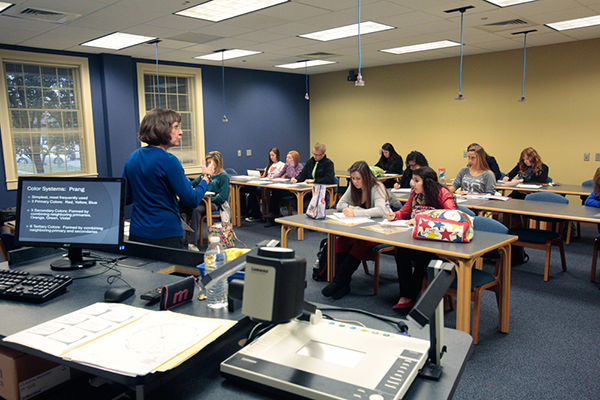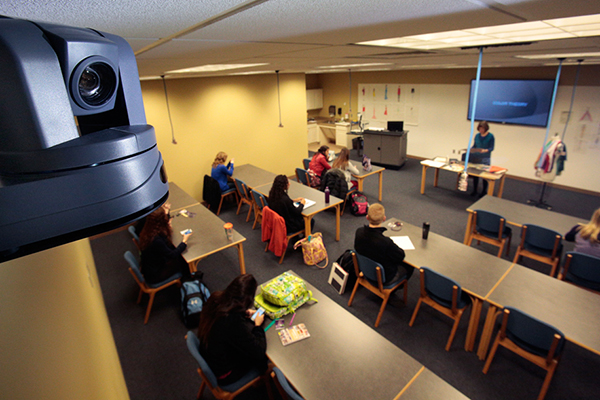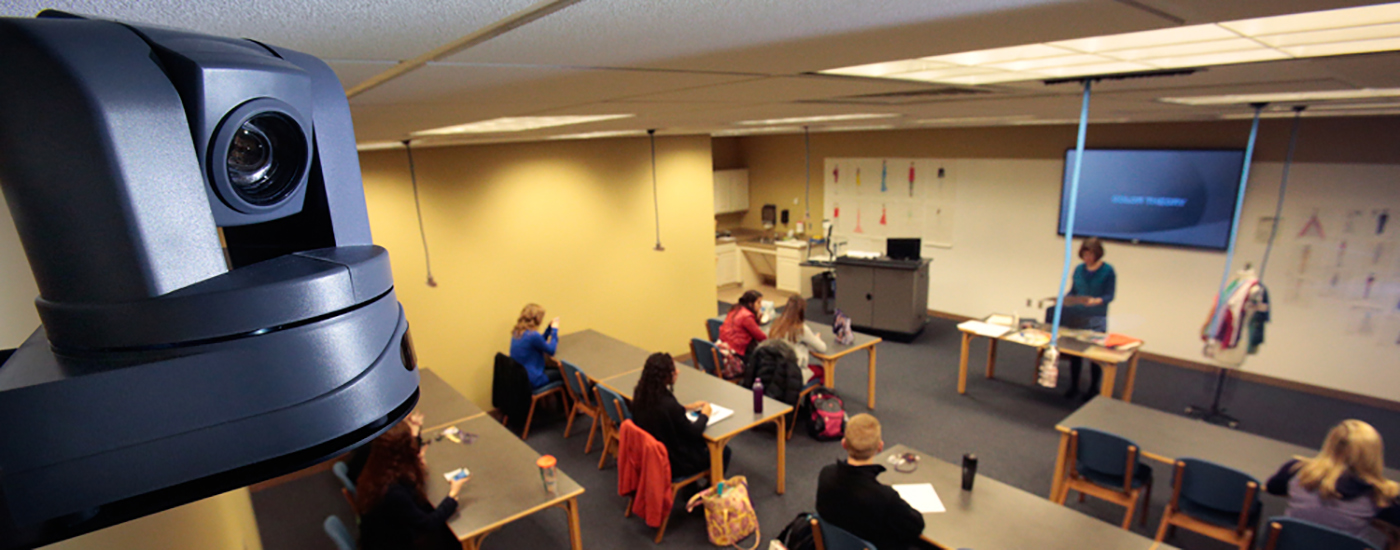High-Tech Fashion
Ashland University in Ohio has a problem, and it’s a great one to have. Its Fashion Merchandising Program is so popular that it’s full every semester. Beyond that single program, the university, located between Akron, Cleveland and Columbus, believes the best way to serve its student body going forward is to add online and hybrid components to all of its programs, opening them up to students who can’t attend in person.
Although the Fashion Merchandising Program at Ashland University has been in existence for 40 over years, it recently moved from the College of Arts and Sciences to the Dauch College of Business and Economics. University officials decided this was the perfect time to make a reinvestment in the program, and they chose to install Vaddio hardware with Mediasite and other software solutions.
“The future of education is the simultaneous delivery of a virtual, synchronized classroom experience and archived lectures to support asynchronous online course delivery,” says Dr. Jeffrey Russell Dean of Ashland’s Dauch College of Business and Economics. “All of these delivery options depend on quality, indexed videos from the classroom and Vaddio helps faculty to meet this expectation in a user-friendly functionality.”

Tom Kemp, Director of Instructional Technology and Learning Management and Brandy Schaad, Audio/Visual Instructional Technician, worked closely with Professor Nancy Morris to engineer a classroom that would propel the Fashion Merchandising Program to an all-new level of excellence.
“We couldn’t expand our Fashion Merchandising programs in the past because they were all classroom-based learning,” says Thomas Kemp, Director of Instructional Technology and Learning Management at Ashland. “It used to cost $20,000 to install a traditional, hardware-based lecture capture instructional learning system. Today, using affordable Vaddio components and software solutions, we can do for around $4,500 for the camera and AV Bridge™ encoder.”
That kind of affordability makes it cost-effective to expand virtual classroom capabilities across the campus.
“We’re really thinking about the engineered online environment at an institutional level,” Kemp said. “Going forward, every time we have an opportunity to remodel or add a classroom in any of our programs, we want it to include hybrid or online functionality.”
FASHION FORWARD: TAILORING THE LEARNING EXPERIENCE
While Ashland currently offers some online and hybrid classes, they primarily exist in the university’s MBA program and other graduate courses. By “wiring” one of the fashion merchandising classrooms, the university hopes to test whether online instruction can give undergraduates educational opportunities comparable to those being offered on the graduate level.
Studies have indicated that students prefer and enjoy the hybrid course format and that it offers them flexibility, freedom and convenience. By allowing students to use technology to work independently in both a traditional and virtual classroom, Ashland believes it can increase student satisfaction. The move toward expanded distance learning opportunities may also help the university’s bottom line.
“Online or hybrid learning currently accounts for 17 to 20 percent of our academic courses,” Kemp says. “We believe we will increase that percentage by adding Vaddio™ audiovisual equipment to support the future online Fashion Merchandising Program.”
Placed in the top 20 percent of fashion merchandising programs in the United States by fashion-schools.org, Ashland University’s Fashion Merchandising Program is one of the only programs of its kind in the area. By adding an online component, Ashland officials realized they would also have the potential to accommodate more students in the program.
“Bringing these technologies together, we now have the ability to capture lectures and stream them online for students who can’t make it to class or who are studying in various parts of the country, as well as abroad,” says Brandy Schaad, Audio/Visual Instructional Technician at Ashland University who served as the chief integrator on the project.
Key to the program’s transformation from classroom-based to classroom-optional is Vaddio’s AV Bridge™. This single piece of hardware provides the key functionality that integrates audio, video and soft codecs like Skype, Cisco Jabber and Microsoft Lync for a fully featured online or hybrid student experience. With its USB gateway, the Vaddio AV Bridge requires no special drivers to be installed, which provides a seamless link to other components including the Mediasite software Ashland uses for video capture. The bridge even allows for easy live streaming of classes.
“The Vaddio AV Bridge truly is the backbone that brings everything together,” Kemp said.
COMPONENTS EASILY WOVEN TOGETHER
Besides the AV Bridge, Ashland’s fashion merchandising classroom features a Vaddio ClearVIEW HD-USB camera mounted at the back of the room to capture students and lecturers, an 80-inch HD plasma display and multiple microphones mounted in the ceiling to capture audio. Mediasite software works smoothly with the AV Bridge to record everything going on in the classroom for later viewing by students. The Mediasite codec also serves as a desktop recorder for the computerized avatars manipulated by instructors and students during presentations to demonstrate fashion-merchandising techniques.
This setup confers many benefits to students. They may easily videoconference with a fashion designer in New York, for example, without having to pass around a microphone or walk to a central podium, like they did in the past. If students miss a class or spend a semester studying abroad, Ashland’s distance learning solution allows them to access recorded classroom discussions on their home computer. Having a high-definition camera in the classroom benefits Ashland instructors, too. They can go beyond traditional lectures to include more active-learning assignments, such as self-tests, tutorials, online group projects and interactive sessions.
VADDIO FITS LIKE A GLOVE
Schaad says Ashland University is looking to gain advanced technology capabilities to enable both real-time remote learning and video capture for rebroadcast. “Using Skype, WebEx, Google Hangouts and Mediasite Lecture Capture coupled with this new technology will allow us to engage with companies and designers, and expose students to the world of fashion merchandising outside of the university,” Schaad says. “It also gives companies the opportunity to see what our students have to offer.”
But why choose Vaddio from among the many available options?
“Vaddio is known for its reliability and customer service,” Kemp said. “For several years, we’ve wanted to develop more of a working relationship with them. The Fashion Merchandising Program offered a nice jumping-off point to test the waters and learn exactly which Vaddio components would be beneficial to support this and other online programs. We already have several AV Bridges installed across the campus, so we were familiar with the quality of Vaddio products. Their affordability made it easy to stay within our budget.”

WORK IT: SHOWCASING STUDENT PROJECTS
As the name suggests, the fashion merchandising program is about marketing and selling ready-to-wear clothing, shoes and accessories; and beyond learning how to market clothing, students in the program learn how to market their skills to prospective employers.
“This new technology will allow us to engage with companies and designers and expose students to the world of fashion merchandising outside of the university,” Kemp says. “It also gives companies the opportunity to see what our students have to offer.”
Studying in a high-tech classroom will enable students to create a visual portfolio that gives them a competitive edge on the job front. For example, students can videotape themselves in the classroom using the Vaddio camera while simultaneously demonstrating their skills by manipulating fashion avatars on their computer screen and capturing the whole performance using Mediasite. This enhanced portfolio allows prospective employers to virtually “meet” the student and view his or her skills in an experience that closely approximates real life.
HIGH-TECH FASHION IN THE REAL WORLD
By equipping its classroom with a Vaddio HD USB camera and AV Bridge, the fashion merchandising program is not only meeting the current needs of its students, but is also preparing them for the types of technology they will encounter as they embark on their careers. From visual merchandising designed to create interest in a company’s clothing to working with buyers via Skype, fashion merchandisers today employ AV technology on many fronts. That means it’s critical for students in the program to be well-versed in its uses.
“It’s easy to envision students who might be preparing for a career as a fashion consultant to create an electronic portfolio with a virtual mannequin,” says Nancy Morris, professor in the Fashion Merchandising Program. “They can show prospective employers why a certain type of pant might look good on a size 6 model, but not a size 12 or vice-versa. This understanding and foresight can make a future buyer in the fashion industry a bigger asset to their company because they are able to support their decision as to the styles and sizes to purchase.”
Morris notes that both the students and faculty are excited about the new Vaddio technology and the way it facilitates reaching out to those in the fashion industry.
“This technology allows us to open up what we can do so others can see the creativity that is happening, “Morris says. “I believe that prospective students will be interested in choosing Ashland based on the fashion shows and other events we have put together.”


